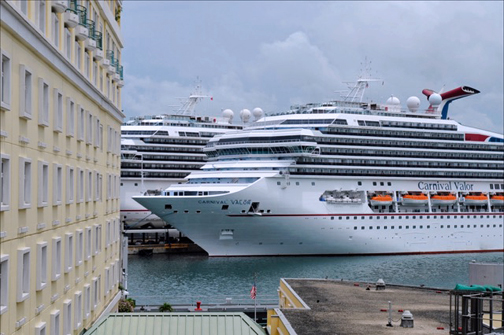FCCA: SJ convention will boost ’17 cruise-ship arrivals


The 110,000-ton Carnival Glory docks at Pier 4 in Old San Juan, not far from where the Florida-Caribbean Cruise Association will hold its annual conference and trade show Sept. 26-30. (Credit: Larry Luxner)
More than 900 people have signed up to attend the Florida-Caribbean Cruise Association’s 23rd annual Cruise Conference & Trade Show, set for Sept. 26-30 in San Juan.
The event, to take place at the Puerto Rico Convention Center, aims to “foster a better understanding of the inner workings of the cruise industry and help attendees improve their cruise tourism business,” according to an FCCA press release.
The gathering includes a “CEO Roundtable” with the bosses of four of the world’s largest cruise ship companies: Mickey Arison, chairman of Carnival Corp.; Orlando Ashford, president of Holland America Line; Richard Sasso, president of MSC Cruises (USA) Inc. and Adam Goldstein, president and chief operating officer of Royal Caribbean Cruises Ltd.
Workshops and panels at the FCCA trade show cover a variety of topics including shore excursions; sourcing and purchasing for the cruise industry; safety, security and best practices, and crisis management. Registration for the event closes Sept. 21; after that, on-site registration costs $1,800 per person.
FCCA officials claim that the last time Puerto Rico hosted this event, in 2011, it led to a 10 percent jump in cruise passenger arrivals within two years.
Citing a 2015 study by Business Research & Economic Advisors, Economic Contribution of Cruise Tourism to the Destination Economies, the FCCA said that San Juan’s growth in 2013, after hosting the show, generated an extra $13.7 million in passenger spending, $3.1 million in crew spending along with $3.4 million in cruise line expenditures and $7.2 million in wages — a total of $27.4 million, not including indirect contributions that include supplies purchased by tour operators, restaurants and port authorities, as well as spending from cruise passengers who return as stayover guests.
If arrivals increase the same 10 percent in 2018, says the FCCA, it would led to 1.78 million passengers and increases of $16.1 million in passenger spending, $3.7 million in crew spending, $3.9 million in cruise line spending and $8.4 million in employment wages—a total of $32.1 million more than 2015.
In 2015, the island received just over 1.7 million cruise ship passengers, up from 1.47 million in 2014. Arrivals will grow another 2 percent in 2016, says Michele Paige, executive director of the FCCA, which has 19 member cruise lines.
“When the current governor [Alejandro García-Padilla] came into office four years ago, the industry was suffering,” Paige told NIMB. “The port was controlled by the unions, and it was very difficult to do business. That is not conducive to providing a service when transportation is a monopoly. And none of the previous governors were willing to take that on. This one did.”
Since then, she said, “everyone, including those who were part of the unions, is doing extremely well.” Per-capita passenger spending in San Juan now stands at $73.12, up from $70.49 in 2012, when the FCCA last conducted such a study. Per-capita spending by crew is also up over the same period, from $122 to $149.
Paige said the FCCA, which also considered Barbados and the Cayman Islands before deciding to hold its 2016 convention in Puerto Rico, said passengers now rank San Juan 12th out of 35 Caribbean destinations in terms of overall satisfaction.
“When we took this survey six years ago, it wasn’t as positive as it is today. This is all reflected in what they’re spending,” said Paige, noting that short excursions, food and beverages, jewelry and incidentals tend to dominate cruise-ship passenger spending while in port.
“Because passengers are having such a phenomenal experience, they go back to stay for a longer-based vacation,” Paige said.
She added that out of 800 people who have registered for the FCCA’s upcoming convention in San Juan, only one has inquired about Zika — a mosquito-borne illness that has been linked to profound birth defects including microcephaly, an abnormally small head caused by the destruction of brain tissue.
The FCCA’s 2017 conference is scheduled for Oct. 23-27 in Mérida, Mexico.












